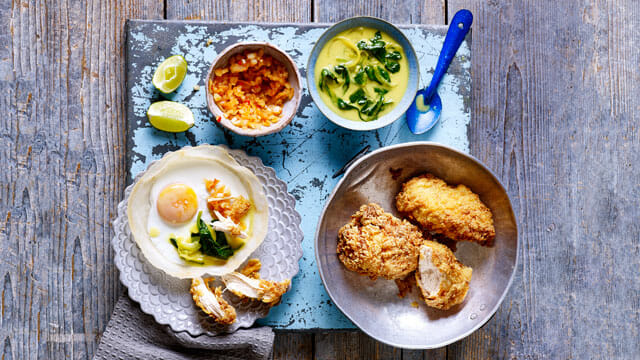Our relationship with food seems to change every day. One day, avocados are to be avoided at all costs due to the dreaded fat content. The next, avocados are so popular that the prices have leapt up and lattes are being served in them. Yes, when it comes to food, it seems like we are quite fickle.
In the last few years, our view on food has dramatically changed and is continuing to do so each day. Together, lets have a look back at our views on food throughout the decades.
1980s
In terms of food trends, this decade was all about the world coming to British shores — Indian dishes were a hit with the public, and Italian pizza found easy popularity alongside its cartoon fans, the Teenage Mutant Ninja Turtles. But it would be the curries of India that really forged a strong bond with British taste buds; in fact, over 20 years later, chicken tikka masala was lauded as a national dish by then-foreign secretary Robin Cook.
But it wasn’t all tasty food and globe-trotting culinary adventures in the 80s. This decade had its own fad diets, with the most notorious being the Beverly Hills Diet. This diet claimed that the problem with weight gain wasn’t down to food, but digestion. Creator Judy Mazel claimed that proteins and carbohydrates should not be digested together — or, more accurately to her claims, that they could not be digested together. Mazel’s theory was that foods that weren’t combined correctly would be stuck in the stomach and remain undigested. These undigested foods would then become fat. The theory was lambasted by doctors, who pointed out that the premise of undigested foods that formed the foundation of Mazel’s diet simply isn’t true.
The dangerous diet required followers to eat specific fruits, in a specific order, for the first 10 days. There was no meat on the original plan until the 19th day of the 42-day plan.
1990s
After enjoying the rise of takeaway staples like pizza and curry in the previous decade, the 90s took a decided more fat-free approach. This was the decade of ‘diet’ and ‘lite’ labels, and the promise that all the foods we loved could have a fat-reduced version that tasted just as good.
Sales of skimmed and semi-skimmed milk soared, overtaking whole milk in this decade. But this focus on diet and fat-free foods clashed strangely with our desire to have everything be convenient. Processed, ready-made, or easy-to-make meals were all the rage, some touting to be ‘diet’…until we later discovered they were filled with other unhealthy ingredients to replace the unhealthy ingredients we knew about.
While consumers were becoming more selective with their food choices, the fad diets hadn’t improved much. This decade’s main contender was the Blood Type Diet. Of course, the Beverly Hills Diet claiming that combining the wrong food would make you fat was ludicrous — foods reacting to your blood type, however, seemed to make sense at the time.
According to Peter J. D’Adamo, the diet’s founder, your blood type affects how food reacts chemically. Therefore, a diet tailored to your blood type would help you digest food more efficiently. Typo Os can eat a lot of meat and less dairy; Type As should avoid meat and stick with fruits and vegetables; Type Bs food plan is full of greens, eggs, a few meats, but avoids chicken; finally, Type ABs don’t get much meat either, nor caffeine or alcohol, but plenty of tofu and seafood.
There is, of course, no research to back the diet’s claim that blood types affect what foods a person should eat.
2000s
Following the 90s desire to eat healthier, but with a new concern over the truth of substitute ingredients used in ‘diet’ alternatives, the 00s began to focus more on organic ingredients. Early in the 2000s, ‘organic’ was the buzzword when it came to produce. This had evolved to a focus on ‘seasonal’ and ‘local’ by the end of the decade, but the thought process behind it was arguably the same — wanting complete transparency on the nature of the food being consumed. GMO food was considered with more than a hint of wariness, and short of heading out to the garden with a bag of mulch and a packet of seeds, people wanted their produce to be as natural and unprocessed as possible.
The decade was all for the infamous Atkins Diet when it came to its trendy fads. The 1972 diet took a few years to be noticed, but it found a huge spotlight in the 2000s thanks to a number of celebrity endorsements. The diet encouraged its followers to ditch the carbs and fill up on protein and fats instead. But it also came with a slew of side effects, such as headaches, weakness, constipation, and fatigue.
2010s
We’re nearly at the end of the 2010s, but what has highlighted our kitchen cupboards this decade? Arguably, the king of the kitchen this decade has been the humble avocado. While fruit has always enjoyed a wide array of praise, the avocado has been something of an outcast in the fruit world until the 2010s. Now, the fat-filled (in a good way) fruit is the icon of a whole generation. Production of avocados worldwide has erupted, from 2.71 million tons in 2000 to 5.92 million tons in 2017.
Alongside this healthy trend, the latter years of the 2010s have been dominated by veganism. In particular, 2019 has been marked to be the ‘year of the vegan’. According to the Vegan Society, one in three Brits have reduced or completely abandoned meat products in their diet, and 92 per cent of vegan meals were consumed by non-vegans. Vegan chocolate has been a big hit, and even global brands such as Greggs jumping on the opportunity.
It’s a similar train of thought that has been simmering across the decades — people want to know where their food is coming from, the processes being directed on it, and in the case of meat production, that it is humane. For some, the act of slaughtering an animal for meat will never be humane, and so, veganism has gone from an often-mocked, scarcely-seen dietary choice to an Instagram-worthy lifestyle choice for the masses.
Of course, with this appetite for health comes a wave of fad diets, and we’ve seen many in the last decade. This decade has had a strange fascination with deprivation: from fasting with the 5:2 diet to cleansing juice ‘detox’ diets, to sugar being the new food-based evil of the world.
Into the 2020s
It won’t be long before we find out what the latest foods to avoid are, and what the next new trends are, as the 2010s decade is nearly over. But there’s certainly enough of a pattern over the last four decades to predict that the 2020s won’t stray far — after really kicking off in the 90s, consumer desire for transparency and fairness throughout the supply chain of their produce has remained as strong as the want for food that is both tasty and healthy.




